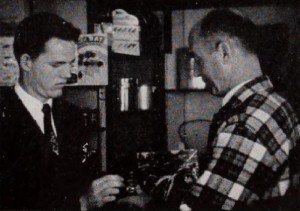
"May Day Conflict is a well executed and skillfully edited family story film of the conflict created by the opening of the trout season and a flower festival both falling on May first. The central character is a good loser (the husband, of course!), as he accompanies his wife to the flower show after elaborate preparations for his fishing trip. Herbert F. Sturdy has deftly woven into the story pattern light, humorous incidents to provide amusing comedy relief from his fine floral closeup studies. Expert camera handling and smooth transitions lend a semi-professional finish to the picture." Movie Makers, Dec. 1948, 493-494.
"'Moods of Nature' by Paul Brunford, recently won a prize in the Institute of Amateur Cinematographers' contest in England. Not only does Brunford show a fine sense of rhythm, but a keen eye for composition and a splendid sense of cutting and dramatic values in nature. This picture merely deals with a storm arising and then subsiding. Brunford uses both water and earth to show this. The smashing waves, bending trees and waving wheatfields combine to create his drama. His photography however, is something for which he is to be especially congratulated." American Cinematographer, Jan. 1936, 24.
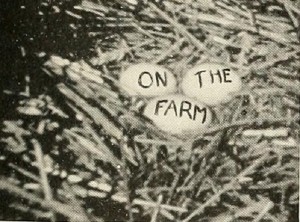
"Sunlight and morning noises, the rich, sweet smell of clover, the hot grain fields at midday and windmills drawing water from the deep earth — these are part of the common life of an Ohio farm that two young girls, Marjean and Mary Elizabeth Headapohl, have put into their film, On the Farm. It is a record as American in feeling as Walderts Pond, even though unconsciously so. Innumerable closeups show the generousness of the earth in Ohio, whether in flowers around the house or in the grain and vegetables of the fields. Day after day, the imponderable clouds drift by. Peas are shelled for dinner; the cows are brought in from the pasture by the collie dog; the farm hands return to the barn after a day of harvesting wheat. There is little more shown, in substance, and presently the film ends. But it leaves one with a conviction that this simple way of life in America cannot easily be changed, and that, as long as people of good hearts make records such as this, we cannot wholly forget that the Republic was founded on the plough." Movie Maker, Dec. 1940, 603-604.
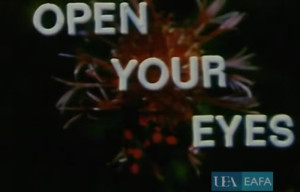
'Amateur filmmaker Dorothy Maxey observes the wildlife in her native Norfolk capturing on Super 8 film a variety of interesting flora and fauna, including at Thompson Common where ponies wade into the pingos and steal the heads from the water violets, and in her own back garden stumbling across wrestling toads. The filmmaker also recalls a story of nursing a poorly mouse following a frosty night by returning home with it to kindly warm him up under the oven grill' (EAFA.org.uk)
"In Pattern of Living we are told how life on this earth probably began. Most likely it started after the upheaval of the sun 5,000 million years ago. Algae and animacules were perhaps the first forms of life, to be followed by the vegetable, and later the worm which was the forerunner of insects as we know them today. Clorophyll, the narrator explains, is responsible for combining water with sunlight to produce sugar that gives energy. Much of the film was shot through a microscope and some animation is used" PSA Journal, Sept. 1965, 51.
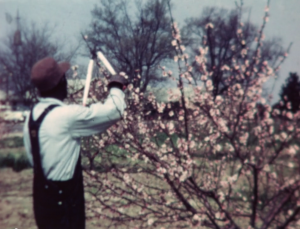
"The life cycle of the peach -- from peach blossom to peach pie" (Holmes, 2018).
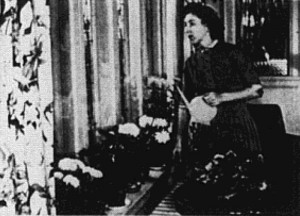
"Spring comes for John W. Ruddell and nature unfolds its little power plants of color and our cameraman has captured these beauties for us. The seed catalog heralds the coming of spring. The housewife busies herself with the new, pretty pages of flower pictures and goes into a bit of slumber. Then followed the results of a tremendous effort in filming single frame, time lapse growth of seeds, plants, trees, and flowers. This is not just another effort to make time lapse photography. The picture is sprinkled with unusual and amusing photographs of plant life and flowers, leaves grasses, carefully timed to the music. The choice and use of music in this picture does a great deal to enhance its effectiveness. A beautiful and delightful prelude to spring." PSA Journal, Nov. 1957, 32.
Prelude to Spring stands as the Canadian Film Awards' de facto Film of the Year for 1957 after the judges did not select a winner in the professional category.
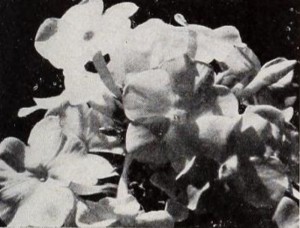
"Revelation indeed reveals the slow, but intense, life of flowers as they unfold. Hans J. Theiler, who built a special mechanism for the purpose, has made time lapse studies of blooms in their determined efforts to find sunlight. Other flowers lose as well as open. The time lapse sequences are preceded by closeup footage of various blooms impeccably filmed. In the chief section of the picture, Mr. Theiler has caught very dextrously the unusual and almost terrifying performances of plants as they carry on their exceedingly active careers. The time lapses are exceptionally smooth." Movie Makers, Dec. 1944, 496.
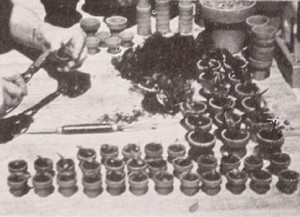
"A. M. Zinner has performed not only a labor of love in Romance of the Hybrid Orchid, but he has made an important contribution to the available information about orchid growing. Given the run of Shaw's Garden, the famous botanical park of St. Louis, he has traced the life of hybrid orchids from seed to full flowering, with especial study of the behind the scenes events in the hot beds and potting rooms. Outstanding is the section of the film devoted to the care and exact technique that must be used in handling seeds while they germinate. With this work of several years, Mr. Zinner takes his place in the ranks of significant amateur naturalists who have provided exhaustive records of some special field. In offering his carefully planned and detailed footage, Mr. Zinner also gives some very lovely flower pictures, including the rarest of the world's orchids. Beautiful camera work and expert sequencing mark the picture." Movie Makers, Dec. 1943, 474.
"The rose, a young girl, so proper, and so elegant in her royal dress, jewelry and jeweled crown. The weed, also a lovely girl, simply dressed and scorned by the rose. By scissors the rose is cut and its petals picked away to the delight of the weed, but then a gloved hand pulls the weed and leaves it to die in the sun. Can it be that some do not like weeds?" PSA Journal, Nov. 1960, 42.
Total Pages: 6